
Dakota County is the third-most populous county in the U.S. state of Minnesota, located in the east central portion of the state. As of the 2020 census, the population was 439,882. The population of Dakota County was estimated to be 443,341 in 2022. The county seat is Hastings. Dakota County is named for the Dakota Sioux tribal bands who inhabited the area.

Henry Hastings Sibley was a fur trader with the American Fur Company, the first U.S. Congressional representative for Minnesota Territory, the first governor of the state of Minnesota, and a U.S. military leader in the Dakota War of 1862 and a subsequent expedition into Dakota Territory in 1863.
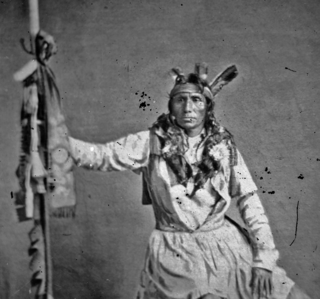
Little Crow III was a Mdewakanton Dakota chief who led a faction of the Dakota in a five-week war against the United States in 1862.
Mississippi River Band of Chippewa Indians or simply the Mississippi Chippewa, are a historical Ojibwa Band inhabiting the headwaters of the Mississippi River and its tributaries in present-day Minnesota.
The Mdewakanton or Mdewakantonwan are one of the sub-tribes of the Isanti (Santee) Dakota (Sioux). Their historic home is Mille Lacs Lake in central Minnesota. Together with the Wahpekute, they form the so-called Upper Council of the Dakota or Santee Sioux. Today their descendants are members of federally recognized tribes in Minnesota, South Dakota and Nebraska of the United States, and First Nations in Manitoba, Canada.

Big Eagle was the chief of a band of Mdewakanton Dakota in Minnesota. He played an important role as a military leader in the Dakota War of 1862. Big Eagle surrendered soon after the Battle of Wood Lake and was sentenced to death and imprisoned, but was pardoned by President Abraham Lincoln in 1864. Big Eagle's narrative, "A Sioux Story of the War" was first published in 1894, and is one of the most widely cited first-person accounts of the 1862 war in Minnesota from a Dakota point of view.

The Treaty of Traverse des Sioux was signed on July 23, 1851, at Traverse des Sioux in Minnesota Territory between the United States government and the Upper Dakota Sioux bands. In this land cession treaty, the Sisseton and Wahpeton Dakota bands sold 21 million acres of land in present-day Iowa, Minnesota and South Dakota to the U.S. for $1,665,000.

Pike Island is an island at the confluence of the Mississippi and Minnesota rivers in the southwestern-most part of Saint Paul in the U.S. state of Minnesota. The island is managed as part of Fort Snelling State Park and is within the Mississippi National River and Recreation Area. For centuries, Dakota people have considered the area of the island to be a sacred place where they moved with the seasons to find food and resources. The island is named after Zebulon Pike, who negotiated the United States government purchase of the area from Mdewakanton Sioux Indians in 1805.
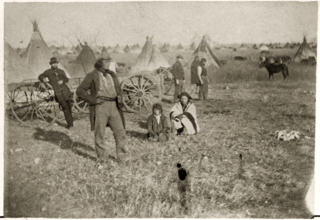
The Surrender at Camp Release was the final act in the Dakota War of 1862. After the Battle of Wood Lake, Colonel Henry Hastings Sibley had considered pursuing the retreating Sioux, but he realized he did not have the resources for a vigorous pursuit. Furthermore, he was aware that Chief Little Crow had been losing support and was in contact with several Mdewakanton chiefs who had signaled their opposition to further conflict.

The US–Dakota War of 1862, also known as the Sioux Uprising, the Dakota Uprising, the Sioux Outbreak of 1862, the Dakota Conflict, or Little Crow's War, was an armed conflict between the United States and several eastern bands of Dakota collectively known as the Santee Sioux. It began on August 18, 1862, when the Dakota, who were facing starvation and displacement, attacked white settlements at the Lower Sioux Agency along the Minnesota River valley in southwest Minnesota. The war lasted for five weeks and resulted in the deaths of hundreds of settlers. In the aftermath, the Dakota people were exiled from their homelands, forcibly sent to reservations in the Dakotas and Nebraska, and the State of Minnesota confiscated and sold all their remaining land in the state. The war also ended with the largest mass hanging in United States history with hanging of 38 Dakota men.
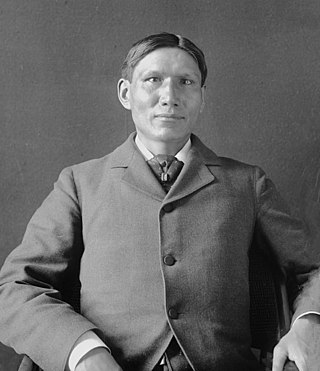
The Dakota are a Native American tribe and First Nations band government in North America. They compose two of the three main subcultures of the Sioux people, and are typically divided into the Eastern Dakota and the Western Dakota.
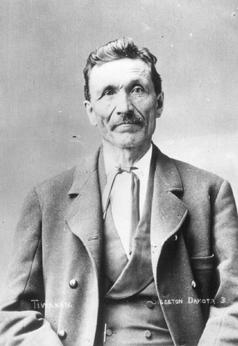
Gabriel Renville, also known as Ti'wakan, was Chief of the Sisseton Wahpeton Oyate Sioux Tribe from 1866 until his death in 1892. He opposed conflict with the United States during the Dakota War of 1862 and was a driving force within the Dakota Peace Party. Gabrielle Renville's influence and political leadership were critical to the eventual creation of the Lake Traverse Indian Reservation, which lies mainly in present-day South Dakota.
Shakopee or Chief Shakopee may refer to one of at least three Mdewakanton Dakota leaders who lived in the area that became Minnesota from the late 18th century through 1865. The name comes from the Dakota Śakpe meaning "Six." According to tribal histories, the very first "Shakpe" was called that because he was the sixth child of a set of sextuplets.

Wabasha II, also known as Wapahasha, Wapasha, or "The Leaf," succeeded his father as head chief of the Mdewakanton Dakota tribe in the early 1800s. He led the Dakota forces fighting with the British in the War of 1812, but sided with the United States in the Black Hawk War of 1832. Chief Wabasha II signed the Treaties of Prairie du Chien in 1825 and 1830.
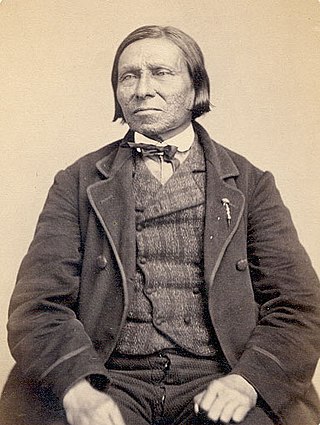
Wabasha III (Wapahaśa) was a prominent Dakota Sioux chief, also known as Joseph Wabasha. He succeeded his father as head chief of the Mdewakanton Dakota in 1836. Following the Dakota War of 1862 and the forced removal of the Dakota to Crow Creek Reservation, Wabasha became known as head chief of the Santee Sioux. In the final years of his life, Chief Wabasha helped his people rebuild their lives at the Santee Reservation in Nebraska.
Wacouta I (Shooter) was a leader of the Red Wing band of Mdewakanton Dakota during the time of United States expansion into his people's homeland.
Red Wing II, also known as Tatankamani was a leader of the Mdewakanton Dakota in the upper Mississippi Valley. During the War of 1812, Chief Red Wing II initially supported the British together with other Dakota chiefs, but switched sides to support the Americans in 1814. His village was at Barn Bluff in present-day Red Wing, Minnesota.
Mendota Mdewakanton Dakota Tribal Community is a Dakota community centered in Mendota, Minnesota. The Mendota Mdewakanton Dakota Tribal Community, colloquially known as MMDTC, is an organization who works to continue Dakota cultural practices and tribal organization. Officially formed in 1997, the MMDTC has sought to be a federally recognized tribe by the US Bureau of Indian Affairs, as well as offering community activities such as Pow Wows, Dakota language and culture classes, and partnership with the Minnesota Historical Society.

Snana (1839–1908), also known as Maggie Brass, was a Mdewakanton Dakota woman who rescued and protected a fourteen-year-old German girl, Mary Schwandt, after she was taken captive during the Dakota War of 1862. She was reunited with Mary Schwandt Schmidt in 1894, leading to a feature article in the St. Paul Pioneer Press. Snana’s narrative of the war, “Narration of a Friendly Sioux,” was edited by historian Return Ira Holcombe and published in 1901.
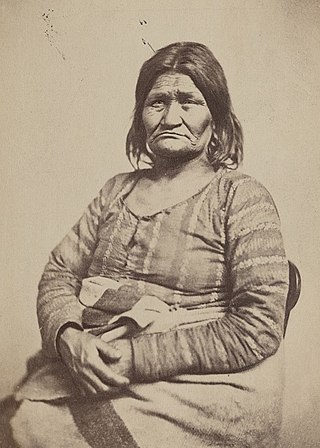
Azayamankawin, also known as Hazaiyankawin, Betsey St. Clair, Old Bets, or Old Betz, was one of the most photographed Native American women of the 19th century. She was a Mdewakanton Dakota woman well known in Saint Paul, Minnesota, where she once ran a canoe ferry service. Old Bets was said to have helped many women and children taken captive during the Dakota War of 1862.















